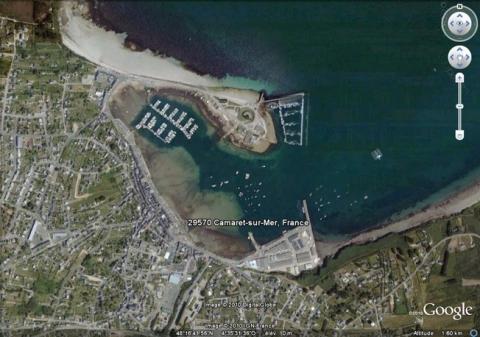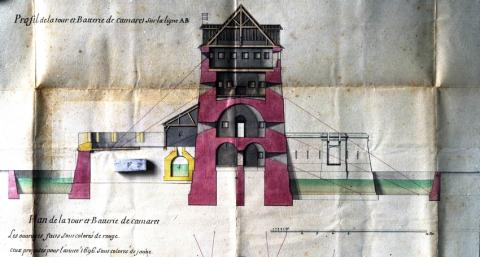Camaret-sur-Mer
History and description
The tour dorée (golden tower) of Camaret-sur-Mer was constructed from 1689 by the engineer Traverse, during the third stay of Vauban in Brest. Its construction can be considered among the significant examples of transformation and reinforcement of the defences of the port-arsenal of Brest, which started six years earlier. It involved obtaining a fulcrum to bar the entry of the goulet de Brest to ships attempting to disembark. Five years later, incomplete, the tower received its baptism of fire when the English navy attempted to attack Brest and force their way through. In Brest at the time, Vauban organised an effective defence, which allowed him to repel the assailant. After this battle, Traverse rapidly completed the tower. It was a defensive tower built on five levels (including roofs), woven into a semi-circular artillery battery. The basement was used for food stores and gunpowder. The battery was surrounded by a moat which flooded at high tide. The tower, hexagonal in shape, was equipped with equipment allowing muskets to be fired. An arms cache took up the third floor and included a firing slot in its fireplace. The name tour dorée comes from the colour of the cement, in red brick.In 1795, a stone fire (to burn approaching ships) was constructed to complete the defence.
Current state
The tower was preserved. Only the roofing, framework and the flooring of the final floor were reconstructed following a fire in 1944. The tower has been classed as a historical monument since 1907 and is included on the World Heritage List as part of the fortifications of Vauban. Numerous cultural projects are underway: the creation of an interpretation centre, the objective of which is to promote the discovery of the works of Vauban in Brittany and first and foremost, his role in the defence of the port-arsenal of Brest. At the same time, this interpretation centre will be intended to encourage those visiting to discover the different fortifications present in the area of the goulet de Brest, Finistère and Brittany. A marine discovery of the bay fortifications was recently set up. The tower is freely open for visits or guided tours from April to October. Numerous educational workshops are also on offer.
Camaret-sur-Mer
Camaret-sur-Mer
48° 16' 48" N, -4° 35' 30" E
Type
coastal artillery tower
Engineers
Sébastien le Prestre de Vauban, Jean-Pierre Traverse
Department
Finistère
Region
Bretagne
Bibliography
- FAUCHERRE (N.), LECUILLIER (G.), La route des fortifications en Bretagne Normandie, Paris, 2006.
- GAUDU (G.), "Boulets rouges et fours à boulets", in Mémoires de la Société d’émulation des Côtes-du-Nord, Saint-Brieuc, 1970.
- MONGIN (M.), STEENBERGEN (M.), Camaret-sur-Mer, la Tour Vauban, « gardienne des côtes d’Armorique », Woippy, 2014. -* Ouvrage collectif, Vauban et ses successeurs dans les ports du Ponant et du Levant : Brest et Toulon, Paris, 2000.
- PEARSALL (A.W.H.), « Le débarquement à Camaret le 8 juin 1694 » in Vauban et ses successeurs dans les ports du Ponant et du Levant : Brest et Toulon, Paris, 2000.
- PETER (J.), Vauban et Brest : une stratégie modèle de défense portuaire (1683-1704), Paris, 1998.

